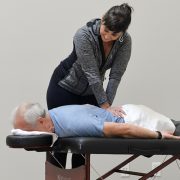Why Rest Might Be the WORST Advice for Your Back Pain
The majority of the people who come through our doors are seeking relief from back pain. Unfortunately, many of them have been told -or have simply assumed- that the best way to recover from their pain is to ice and lie down – and use their back muscles as little as possible. They’ve been advised to rest, relax, and limit their movement until the pain goes away.
The problem with this model for treatment is that it goes against everything we know about the basic principles of joint and tissue healing. Our modern health research suggests that early movement is actually the BEST way to head off chronic back pain! Of course, if you’ve suffered a trauma like a car accident or a major fall, you should absolutely go get checked out by a medical professional and follow their advice based on your injuries. But if you are dealing with a chronically aching back or general soreness, stiffness, and pain, it turns out that movement is actually the best course of action!
Of course, not ALL types of movement and exercise are safe or beneficial when you’ve hurt your back…
That’s where physical therapy comes in! A physical therapist is able to identify specific movements that actually work through and relieve that pain, based on your individual condition. We call these initial exercises “first aid movements” – and they are especially helpful because you can use them any time you might tweak your back in the future! Knowing the specific movements that can help your back muscles relax and work fluidly with the rest of your body again can be a lifesaver if you work a physical job or rely on your ability to be active and mobile every day. And NOT knowing these movements can prolong your back injury and give it a better chance of coming back… often much sooner than you’d like.
If you’re experiencing acute back pain, of course it doesn’t make sense to continue with all of your activities as usual if they are just exacerbating your symptoms. But there is a middle ground between overdoing it and completely stopping the movement that your body craves. Talk to a physical therapist who specializes in back pain so they can help you figure out which movement is the safest and best for a quick and early recovery from back pain.
If you’re dealing with back pain right now and want to start learning how you can help yourself through movement (instead of pills) right away, check out our FREE report right here!







